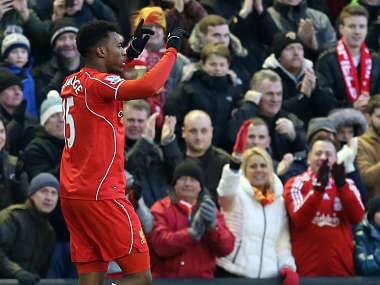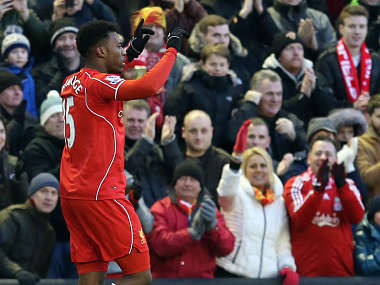‘SEEING is Believing’, read the name of the initiative displayed on the front of Liverpool’s shirts during their entertaining 3-2 win against Tottenham, a visual show of the club’s continued support for a global charitable campaign which seeks to tackle avoidable blindness around the world. A good deed on the part of the club, undoubtedly, but the message itself, with its reference to belief, seems to resonate with the increasingly positive fortunes of Brendan Rodgers’ men. Belief, something that appeared to desert Rodgers’ charges during the long and desperate days of autumn and early winter, is back at Anfield. And so too is Daniel Sturridge. Twelve minutes was all it took for Sturridge to neatly encapsulate all that Liverpool had missed during his five long months away from the first team as he marked his return from injury with a goal against West Ham at the end of January. The intelligent run away from his marker, the close control, the assuredness, the confidence, the shot, the goal. The Anfield faithful have seldom been that pleased to see the striker joyfully ‘riding the wave’ in celebration. [caption id=“attachment_2092443” align=“alignleft” width=“380”]  Liverpool’s Daniel Sturridge celebrates scoring on his return to the first team. AP[/caption] Liberated from Luis Suarez’s shadow, this was supposed to be the season when the 25-year-old definitively established himself as England’s pre-eminent striker, after excelling as an out-and-out centre-forward during his first season and a half on Merseyside. But alas for Sturridge, and for Liverpool, the best-laid plans of mice and men often go awry – and in their case, it did. An injury, suffered on international duty in the second week of September, was meant to sideline him for three weeks. Then, a month later, he was ruled out for a further three weeks. And then, in mid-November, he broke down in training once again and was confined to the treatment table until the New Year. Shorn of his sharpest attacking sword, Rodgers failed to elicit the best out of the comparatively blunt trio of Mario Balotelli, Rickie Lambert and Fabio Borini, and instead opted to tweak his system and deploy Raheem Sterling at the apex of his attack, mindful that the youngster’s pace and movement could replicate that of his fellow England international. And while that has triggered an upturn in results, it did not necessarily provide Liverpool with the clinical edge that propelled them toward their title tilt last term. Step forward Sturridge. Having accrued 76 minutes of first-team action over the course of three substitute appearances since the end of January, Sturridge was handed his first Premier League start against Tottenham on Tuesday night, 163 days after he had made his last top-flight start, coincidentally, against the same opponents. The impact of his re-emergence was abundantly clear within the opening 15 minutes –sharp, alert and opportunistic, three times he got in behind the last defender, but on each occasion he was thwarted by Hugo Lloris. And then, with 15 minutes on the clock, his excellent run toward the right-hand side of the box created space for the advancing Lazar Markovic on the other side. The Serbian took advantage of the gap that opened in front of him and fired beyond Lloris to put Liverpool in front. After Harry Kane’s equaliser, it was Sturridge who took the initiative as Liverpool went in search of another – his ingenious improvised backheeled effort on the stroke of half-time cannoned off the post, while it was his jinking run inside the box which drew a foul from Danny Rose and earned a penalty, which Steven Gerrard despatched to make it 2-1. It takes two players to turn a pass into a through ball and Sturridge offers the vital second component in that process, providing the outlet with his searing pace and intelligent movement, notwithstanding his finishing ability. Liverpool have not struggled to create chances this season, but they have struggled to take them – in the five Premier League games where they failed to score in Sturridge’s absence this season, they produced a combined total of 75 shots (15 shots per game), but only 19 of those shots (25%) were on goal. On Tuesday, Sturridge ended the evening having made more shots (five) than any other player on the pitch, and 40% of his efforts found the target, with another one hitting the post. Sturridge’s return has certainly come at a timely juncture, with Liverpool immersed in a battle with Spurs, Arsenal, Manchester United and Southampton for a top-four berth. The Merseysiders are the form team in the Premier League – indeed only seven teams in the five major European leagues have accrued results better than Liverpool over their past six matches – and the return of their trusty marksman has provided them with just the fillip they need as they look to secure Champions League football at Anfield next season.
Twelve minutes was all it took for Sturridge to neatly encapsulate all that Liverpool had missed during his five long months away from the first team as he marked his return from injury with a goal against West Ham at the end of January.
Advertisement
End of Article


)

)
)
)
)
)
)
)
)



